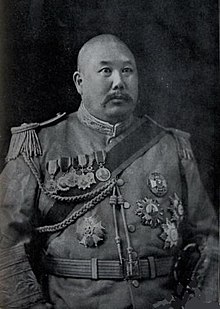Ma Fuxiang 馬福祥 مَا فُثِیَانْ | |
|---|---|
 Lieutenant General Ma Fuxiang | |
| Acting Chief Executive Officer of Kokonur (Qinghai, then a region of Gansu Province) | |
| In office July 1912 – August 1912 | |
| Preceded by | Qing Shu (Ch'ing Shu) |
| Succeeded by | Lian Xing (Lien Hsing) |
| Military Governor of Ningxia (then a region of Gansu Province) | |
| In office 1912–1920 | |
| Preceded by | Chang Lian (Ch'ang Lien) |
| Succeeded by | Ma Hongbin (Ma Hung-pin) |
| Military Governor of Suiyuan Province | |
| In office 26 May 1921 – January 1925 | |
| Preceded by | Cai Chengxun (Ts'ai Ch'eng-hsün) |
| Succeeded by | Li Minzhong (Li Min-chung) |
| Mayor of Qingdao[1][2] | |
| In office November 1929 – March 1930 | |
| Preceded by | Wu Siyu (Wu Szu-yü) |
| Succeeded by | Ge Jingen (Ke Chin-ken) |
| Governor of Anhui Province | |
| In office March 1930 – September 1930 | |
| Preceded by | Wang Chin-yü (Wang Jinyu) |
| Succeeded by | Ch'en Tiao-yuan (Chen Diaoyuan) |
| Chairman of the Mongolian and Tibetan Affairs Commission[3] | |
| In office 8 September 1930 – 30 December 1931 | |
| Preceded by | Yan Xishan |
| Succeeded by | Shi Qingyang |
| Personal details | |
| Born | 4 February 1876 Linxia County, Gansu, Qing Empire |
| Died | 19 August 1932 (aged 56) Beijing, Republic of China |
| Nationality | Hui |
| Political party | Kuomintang |
| Children | Ma Hongkui[3] |
| Awards | Order of Rank and Merit Order of the Precious Brilliant Golden Grain Order of Wen-Hu Order of Leopold (Belgium)[4] |
| Military service | |
| Allegiance | |
| Years of service | 1889–1932 |
| Rank | General |
| Unit | Kansu Braves |
| Commands | Governor of Altay |
| Battles/wars | Dungan revolt (1895–1896), Boxer Rebellion, Zhili–Anhui War, Second Zhili–Fengtian War, Central Plains War, Northern Expedition |
Ma Fuxiang (traditional Chinese: 馬福祥; simplified Chinese: 马福祥; pinyin: Mǎ Fúxiáng; Wade–Giles: Ma Fu-hsiang, Xiao'erjing: مَا فُثِیَانْ, French romanization: Ma-Fou-hiang or Ma Fou-siang;[5] 4 February 1876 – 19 August 1932) was a Chinese Muslim scholar and military and political figure, spanning from the Qing Dynasty through the early Republic of China. His positions illustrated the power of family, the role of religious affiliations and the interaction of Inner Asian China and the national government of China.[6] A prominent Muslim warlord in northwest China,[7][8] Ma Fuxiang originally served under Dong Fuxiang, like other Ma Clique Muslim warlords such as Ma Anliang.[9]
| Part of a series on Islam in China |
|---|
 |
|
|
Ma was born in Linxia, Gansu. He was named the military governor of Xining and then of Altay, in Qing times. He held a large number of military posts in the northwestern region after the founding of the republic. He was governor of Qinghai in 1912, Ningxia from 1912 to 1920, and Suiyuan from 1920 to 1925. Having turned to Chiang Kai-shek in 1928, he was made chairman (governor) of the government of Anhui in 1930.[10] He was elected a member of the National Government Commission and then appointed the mayor of Qingdao, special municipality.[11] He was also the president of the Mongolian–Tibetan Commission and a member of the Central Executive Committee of the Kuomintang. He died in August 1932.[12][13]
- ^ "青岛首任市长马福祥" [Qingdao's first mayor Ma Fuxiang]. qingdaonews.com. 29 June 2014. Archived from the original on 4 March 2016. Retrieved 13 August 2015.
- ^ "2muslim.com". Archived from the original on 10 June 2016. Retrieved 14 April 2016.
- ^ a b Schram, Stuart R., ed. (1992). Mao's Road to Power – Revolutionary Writings, 1912–1949: The Pre-Marxist Period, 1912–1920, Volume 1. Vol. 5 (illustrated ed.). M.E. Sharpe. p. 62. ISBN 1563244578.
- ^ Heylen, Ann (2004). Chronique du Toumet-Ortos: Looking through the lens of Joseph Van Oost, Missionary in Inner Mongolia (1915–1921). Leuven, Belgium: Leuven University Press. p. 203. ISBN 90-5867-418-5.
- ^ Heylen, Ann (2004). Chronique Du Toumet-Ortos: Looking Through the Lens of Joseph Van Oost, Missionary in Inner Mongolia (1915–1921). Vol. 16 of Louvain Chinese studies (illustrated ed.). Leuven University Press. p. 373. ISBN 9058674185.
- ^ Howard L. Boorman, Richard C. Howard, eds., Biographical Dictionary of Republican China (New York: Columbia University Press, 1968) Vol 2, pp. 464–65.
- ^ Andrew, G. Findlay (1921). The Crescent in North-West China. With Illustrations.
- ^ Harris, Fred (2007). The Arabic Scholar's Son: Growing Up in Turbulent North China (1927–1943). AuthorHouse. p. 53. ISBN 978-1467822336.
- ^ Chinese Republican Studies Newsletter, Volumes 1–7. Contributors University of Connecticut. Dept. of History, Denison University. Dept. of History, University of Illinois at Urbana-Champaign. Center for Asian Studies. Center for Asian Studies, University of Illinois. 1975. p. 171.
{{cite book}}: CS1 maint: others (link) - ^ Morrison, George Ernest (1978). Lo (Luo), Hui-Min (Huimin) (ed.). The Correspondence of G. E. Morrison 1912–1920. Vol. 2 of The Correspondence of G. E. Morrison, George Ernest Morrison (illustrated ed.). Cambridge University Press. p. 474. ISBN 0521215617.
- ^ American Asiatic Association (1940). Asia: journal of the American Asiatic Association, Volume 40. Asia Pub. Co. p. 660.
- ^ George Ernest Morrison; Hui-Min Lo (1978). The Correspondence of G. E. Morrison 1912–1920. CUP Archive. p. 474. ISBN 0-521-21561-7.
- ^ "宝贝想尿就尿出来 - 全部章节在线阅读-红星读书屋".
© MMXXIII Rich X Search. We shall prevail. All rights reserved. Rich X Search
